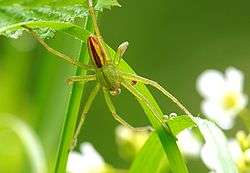Micrommata virescens
| Micrommata virescens | |
|---|---|
 | |
| Male of Micrommata virescens | |
.jpg) | |
| Female of Micrommata virescens | |
| Scientific classification | |
| Kingdom: | Animalia |
| Phylum: | Arthropoda |
| Class: | Arachnida |
| Order: | Araneae |
| Family: | Sparassidae |
| Genus: | Micrommata |
| Species: | M. virescens |
| Binomial name | |
| Micrommata virescens (Clerck, 1757) | |
| Synonyms | |
| |
Micrommata virescens, common name green huntsman spider, is a species of huntsman spiders belonging to the family Sparassidae.
Distribution
This species has a palearctic distribution.[1] M. virescens is the only European representative of the family Sparassidae, most species of which are found in the tropics. It occurs naturally in Northern and Central Europe, including Denmark and southern Britain.[2][3][4]
Description
In the females of Micrommata virescens the body length can reach 12–16 millimetres (0.47–0.63 in), while in the males it is about 7–10 millimetres (0.28–0.39 in).[5]
The cephalothorax and the long legs of the females are bright green, with a lighter green abdomen showing a darker green median stripe. The eight eyes are arranged in two rows and surrounded by white hairs.[2] Males are dark green-olive and have a narrower abdomen, with red sides and a red to red-brown median stripe bordered yellow.[6] Young spiders have a yellow-brown cepahlothorax, with dark marginal and median stripes. Only after the last molting in the following spring the juveniles assume the typical coloration of the adults.
The green coloration is due to the bilin micromatabilin[7] and its conjugates in haemolymph, interstitial tissues and the yolk of oocytes.[8] A bite from this spider on a human may cause some local swelling and a little bit of pain, and would be gone within 2 days.[9]
Habitat
These characteristic huntsman spiders can be found at the edges of forests, in dry meadows, in damp woodland clearings and rides, where they prefer grass and the lower branches of trees.[6]
Biology
These spiders are mainly diurnal. They do not build a web, and hunt insects in green vegetation, where they rely on their camouflage. Their green color makes them very difficultly to be detected by predators.[6] They grow relatively slowly, taking 18 months to reach maturity.[2] Females are mature from May through to September. A few days after mating, the males die. In July the females enclose the egg-sac into a few leaves stitcheed together.[4] Cocoons are guarded by females. After about 4 weeks eggs hatch about 40-50 young spiders.[2]
References
- ↑ Platnick, Norman I. (10 December 2011). "Fam. Sparassidae". The World Spider Catalog, Version 12.5. New York, NY, USA: American Museum of Natural History. doi:10.5531/db.iz.0001. Retrieved 22 April 2012.
- 1 2 3 4 Natur-lexikon
- ↑ The Spiders of Europe and Greenland. Family: Sparassidae (Giant Crab Spiders) (list)
- 1 2 "Summary for Micrommata virescens (Araneae)". British Arachnological Society. Retrieved 30 August 2016.
- ↑ Araneae
- 1 2 3 A bug blog
- ↑ A. Holl & W. Rüdiger (1975). "Micromatabilin, a new biliverdin conjugate in the spider, Micromata rosea [sic] (Sparassidae)". Journal of Comparative Physiology B. 98 (2): 189–191. doi:10.1007/BF00706130.
- ↑ G. S. Oxford & R. G. Gillespie (1998). "Evolution and ecology of spider coloration". Annual Review of Entomology. 43 (1): 619–643. doi:10.1146/annurev.ento.43.1.619. PMID 15012400.
- ↑ BobinOz
Further reading
- A. Bayram & S. Özda (2002). Micrommata virescens (Clerck, 1757), a new species for the spider fauna of Turkey (Araneae, Sparassidae). Turkish Journal of Zool 26: 305–307 PDF
External links
 Media related to Micrommata virescens at Wikimedia Commons
Media related to Micrommata virescens at Wikimedia Commons- Macro-Photographs and information on Micrommata virescens (German language)